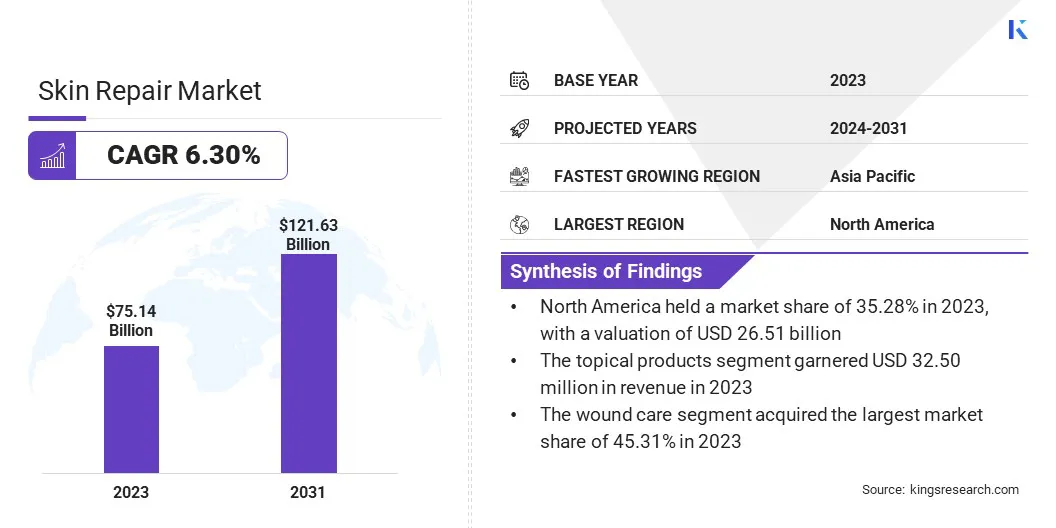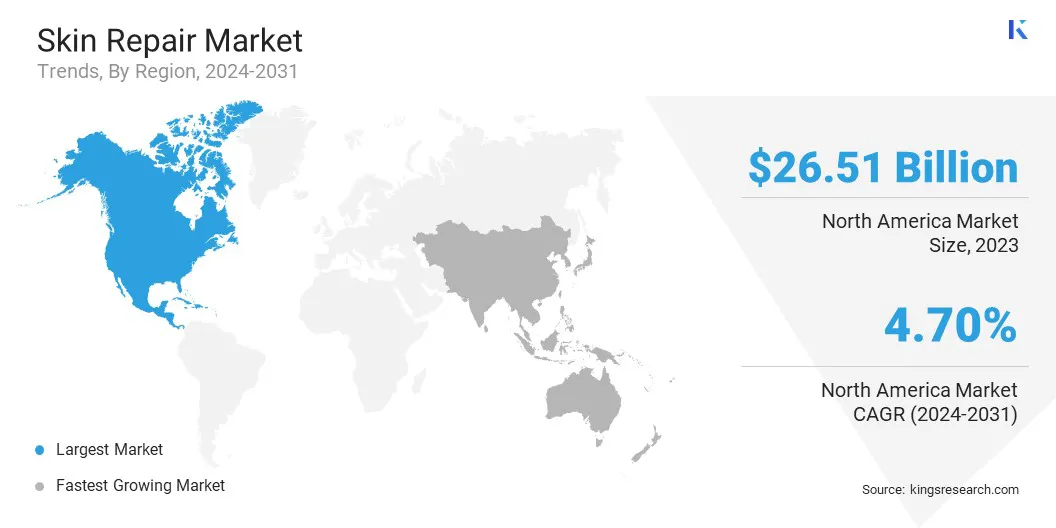Skin Repair Market Size
The global Skin Repair Market size was valued at USD 75.14 billion in 2023 and is projected to reach USD 121.63 billion by 2031, growing at a CAGR of 6.30% from 2024 to 2031. In the scope of work, the report includes solutions offered by companies such as L'Oréal S.A., The Estée Lauder Companies Inc., Johnson & Johnson, Procter & Gamble Co. (P&G), Unilever PLC, Beiersdorf AG, Shiseido Company, Limited, Amorepacific Corporation, Kao Corporation, Avon Products, Inc. and Others. The aging population is driving market expansion in the skincare industry, with a growing demand for skin repair products and treatments to address age-related concerns such as wrinkles, fine lines, and age spots. This demographic trend presents a significant growth opportunity for companies to develop innovative solutions catering to age-related skin issues, thereby fueling the growth of the skin repair market.
Moreover, rising consumer awareness of skincare is driving market expansion, as informed consumers seek advanced solutions for aging, sun damage, and environmental stressors. This demand fuels the need for innovative skin repair and rejuvenation products, thereby prompting companies to invest in research and development for cutting-edge technologies and targeted treatments. By educating consumers about product benefits and leveraging advanced formulations, market players aim to capitalize on this trend, leading to continuous innovation and an increased demand for high-quality skin repair solutions.
Additionally, expansion into emerging markets presents a significant opportunity for market growth, fueled by rising disposable incomes and increasing consumer awareness. As economies develop, there is a growing demand for advanced skincare solutions, allowing market players to introduce tailored products, adapt pricing strategies, and implement targeted marketing campaigns to capture significant market share, thereby driving market expansion.
Skin repair encompasses restoring damaged skin through treatments, products, and regimens, to address concerns such as wounds, scars, aging signs, and environmental damage. Its applications span medical, cosmetic, and dermatological fields, treating burns, injuries, surgical wounds, eczema, and psoriasis medically while focusing cosmetically on anti-aging and scar reduction. Advances in skincare technologies are expanding their scope, catering to diverse needs and enhancing skin quality across various demographics.

Analyst’s Review
In the competitive skin repair market, companies are prioritizing R&D for innovative formulations, conducting clinical trials, and investing in brand-building through effective marketing practices to expand their global footprint. Adhering to both local and international regulations, including safety, labeling, and marketing claims, is paramount. This involves thorough testing, accurate labeling, and compliance with guidelines set by regulatory bodies such as the FDA in the United States or the EU Cosmetics Regulation in Europe. Establishing robust quality control processes, conducting regular audits, and staying updated with regulatory changes are crucial steps to ensure compliance and build a trustworthy brand reputation.
Skin Repair Market Growth Factors
Technological advancements are driving growth and innovation in the skincare industry, particularly through advanced ingredients that target aging, pigmentation, and hydration. These ingredients, often derived from natural sources or developed through cutting-edge research, offer enhanced efficacy and safety. Innovations in delivery systems, ranging from microencapsulation to nanoemulsions, optimize the penetration of key ingredients into targeted skin layers, thereby maximizing their benefits.
Additionally, non-invasive treatments such as laser therapies and ultrasound devices offer effective results with minimal downtime, which appeals to consumers seeking safe and convenient skincare solutions. These advancements are playing a crucial role in the skincare industry by providing more effective, targeted, and accessible skin repair solutions.
Additionally, customized skincare solutions are revolutionizing the beauty industry by offering personalized treatments tailored to individual skin types, concerns, and genetic factors. Leveraging technology such as skin analysis apps, DNA testing, and AI algorithms, companies are developing personalized skincare regimens tailored to address specific concerns such as acne, aging, and pigmentation. This trend enhances efficacy while improving customer satisfaction, thereby driving demand for tailored solutions.
Opportunities for brands include differentiation, stronger customer relationships, and capitalizing on the growing interest in self-care. Personalized skincare holds the potential to enhance outcomes by providing targeted treatments that address individual skin issues more effectively, which reflects the trend toward holistic wellness and individualized experiences.
However, navigating competition and brand differentiation in the global skin repair market is challenging due to the saturation of brands offering a wide array of products. Establishing a strong brand identity involves highlighting effectiveness and unique value proposition, backed by robust marketing strategies.
Key differentiators such as innovative ingredients, advanced formulations, sustainable practices, or specific target demographics play a pivotal role in fostering market prominence. Continuous innovation, ongoing research, clinical studies, endorsements, and transparent labeling contribute to building trust and facilitate brand differentiation. Collaborations with influencers, partnerships, and leveraging social media platforms play crucial roles in engaging target audiences. Brands that navigate these challenges and offer compelling, differentiated solutions are poised to succeed in the market.
Skin Repair Market Trends
The integration of biotechnology into skincare formulations is revolutionary, utilizing stem cell research for skin regeneration, gene editing for customized solutions, and microbiome science for probiotic products. AI-driven skincare solutions analyze vast amounts of data to provide personalized diagnostics and treatment recommendations, thereby optimizing outcomes. Additionally, AI-powered skincare devices offer real-time feedback, which enhances efficacy.
Moreover, with growing environmental awareness, there is a rising demand for eco-friendly skincare products and sustainable packaging solutions. Brands are adopting sustainable sourcing practices, using recycled materials, and minimizing carbon footprints, thereby contributing significantly to environmental conservation efforts and enhancing brand reputation. This shift toward advanced biotechnology, AI-driven solutions, and sustainability reflects the industry's commitment to innovation, personalization, and environmental responsibility.
Segmentation Analysis
The global skin repair market is segmented based on product type, application, end-user, and geography.
By Product Type
Based on product type, the market is segmented into topical products, injectable products, and skin repair devices/technology. The topical products segment garnered the highest revenue of USD 32.50 billion in 2023. Topical products such as creams, lotions, and serums are widely used by consumers for daily skincare routines, thus making them easily accessible and popular. Additionally, the growing emphasis on moisturization and skincare by organizations such as the American Academy of Dermatology (AAD) reinforces the importance of topical products in maintaining skin health and addressing concerns such as wrinkles, thereby driving higher sales and revenue in this segment.
By Application
Based on application, the market is bifurcated into wound care, scar reduction & management, and cosmetic applications. The wound care segment acquired the largest market share of 45.31% in 2023. This dominance can be accredited to the significant prevalence of chronic wounds, which drives the demand for effective wound care products and treatments.
According to the Agency for Healthcare Research and Quality (AHRQ), chronic wounds affect millions of Americans annually, leading to substantial healthcare expenditures. This creates a significant market opportunity for products specifically designed for wound care management and healing. The growing aging population and rising incidence of conditions such as diabetes further contribute to the surging demand for advanced wound care solutions, thereby bolstering the share of the wound care segment.
By End-User
Based on end-user, the market is classified into hospitals & clinics, pharmacies & drugstores, online retailers, and department stores & beauty stores. The online retailers segment is poised to grow at a robust CAGR of 8.75% over the forecast period. The increasing adoption of e-commerce platforms and digitalization has led to a notable surge in online shopping for skincare products. Consumers are increasingly turning to online retailers for convenience, a wide range of product options, and competitive pricing. Additionally, advancements in logistics and delivery services have improved the efficiency and reliability of online shopping experiences, thereby driving the growth of this segment.
Skin Repair Market Regional Analysis
Based on region, the global market is classified into North America, Europe, Asia-Pacific, MEA, and Latin America.

The North America Skin Repair Market share stood around 35.28% in 2023 in the global market, with a valuation of USD 26.51 billion. This growth can be attributed to robust healthcare infrastructure, high consumer awareness regarding skincare, and substantial investments in medical research. The National Institutes of Health (NIH) budget for fiscal year 2024, allocating over USD 40 billion to medical research, includes a significant portion dedicated to skin conditions. This funding supports research initiatives, clinical trials, and the development of innovative skin repair treatments, thereby contributing to North America's continued dominance in the market.
Asia-Pacific is projected to witness significant growth in the skin repair market over the forecast period, accounting for a valuation of USD 37.35 billion by 2031. This growth is mainly driven by several factors such as increasing disposable income levels, changing lifestyles leading to higher skincare awareness, and a growing aging population in countries such as China, Japan, and South Korea. Additionally, the rising demand for advanced skincare products, coupled with expanding beauty and wellness industries across the region, contributes to the positive regional market outlook. These trends collectively indicate a promising market landscape for skin repair products in the region.
Competitive Landscape
The global skin repair market report will provide valuable insight with an emphasis on the fragmented nature of the industry. Prominent players are focusing on several key business strategies such as partnerships, mergers and acquisitions, product innovations, and joint ventures to expand their product portfolio and increase their market shares across different regions. Strategic initiatives, including investments in R&D activities, the establishment of new manufacturing facilities, and supply chain optimization, could create new opportunities for market growth.
List of Key Companies in the Skin Repair Market
Key Industry Developments
- January 2024 (Partnership): Direct-to-consumer (DTC) skincare brand Curology announced a strategic e-commerce partnership with Amazon. This collaboration aimed to expand Curology's online presence and enhance accessibility to its dermatology-backed skincare products for Amazon's vast customer base. The partnership reflected a mutual interest in leveraging e-commerce channels to record considerable growth and expand market reach.
- July 2023 (Partnership): Soteri Skin and Clinikally joined forces to enter the Asian skin repair market. This strategic partnership aimed to leverage Clinikally's expertise in dermatological solutions and Soteri Skin's innovative skincare products to cater to the growing demand for high-quality beauty and wellness offerings in Asia.
The Global Skin Repair Market is Segmented as:
By Product Type
- Topical Products
- Injectable Products
- Skin Repair Devices/Technology
By Application
- Wound Care
- Scar Reduction & Management
- Cosmetic Applications
By End-User
- Hospitals & Clinics
- Pharmacies & Drugstores
- Online Retailers
- Department Stores & Beauty Stores
By Region
- North America
- Europe
- France
- U.K.
- Spain
- Germany
- Italy
- Russia
- Rest of Europe
- Asia-Pacific
- China
- Japan
- India
- South Korea
- Rest of Asia-Pacific
- Middle East & Africa
- GCC
- North Africa
- South Africa
- Rest of Middle East & Africa
- Latin America
- Brazil
- Argentina
- Rest of Latin America


